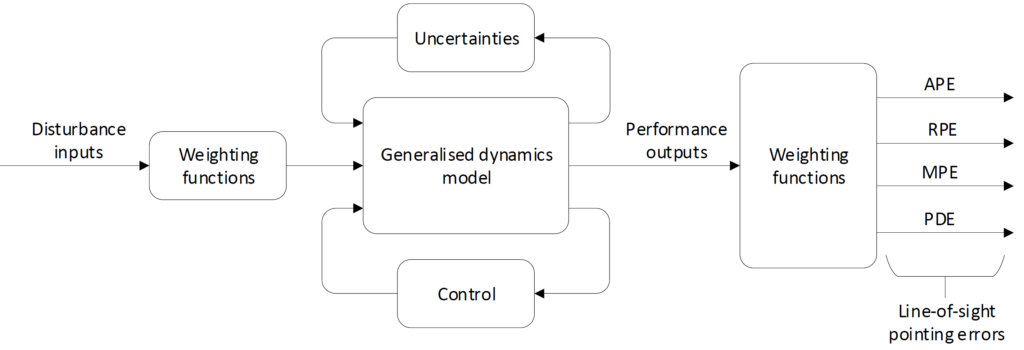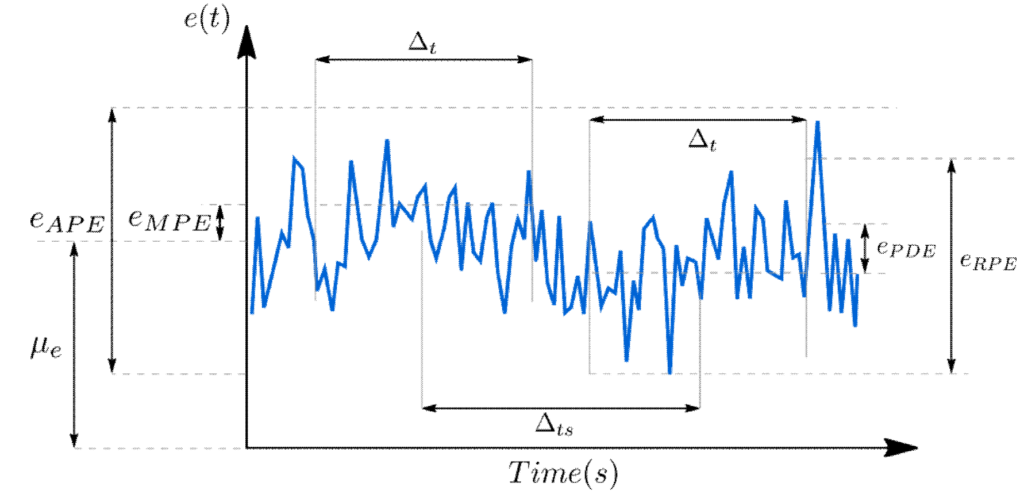IQClab facilitates the robustness analysis and control design for attitude and orbital control systems (AOCS) (i.e. pointing systems) by means of dedicated performance weighting functions.
In other words, IQClab allows defining dedicated pointing matrices, which yield the quality of the pointing as a function of the variability of the system in the presence of the modelled uncertainties. This is illustrated in the following figure.

A main advantage of IQClab is that it facilitates the direct minimization of the ![]() -norm, which is not possible with the
-norm, which is not possible with the ![]() -tools.
-tools.
Pioneering work in this direction, especially on the definition of the weighting functions, was performed by Pittelkau (see e.g., [13]). The application of such weights in the ![]() setting and using the
setting and using the ![]() -tools was presented in [14].
-tools was presented in [14].
The following figure depicts some relevant performance error metrics have been defined by the European Cooperation for Space Standardization (ECSS) in, for example ECSS-E-ST-60-10C.

Here the error metrics are defined by:
| Index | Description |
| APE | The absolute performance error (APE) is the difference between the target- and the actual pointing direction: |
| RPE | The relative performance error (RPE) is the difference between the APE at a give time within a time interval |
| MPE | The mean performance error (MPE) is the mean value of the APE over a specific time-interval |
| PDE | The performance drift error (PDE) is the difference between the MPEs taken over two time intervals separated by a specified time |
The term ![]() denotes the confidence level of the requirement (e.g.,
denotes the confidence level of the requirement (e.g., ![]() for 68.3%,
for 68.3%, ![]() for 95.5% and
for 95.5% and ![]() for 99.7%). It is emphasized that the standard deviation of the RPE requirement depends on the specified time interval
for 99.7%). It is emphasized that the standard deviation of the RPE requirement depends on the specified time interval ![]() , while the PDE requirement depends on both
, while the PDE requirement depends on both ![]() and the time between intervals
and the time between intervals ![]() . In addition, the standard deviation, denoted by
. In addition, the standard deviation, denoted by ![]() , of the above metrics can be analysed by means of the PSD of the pointing error signals, which are assumed to be zero-mean stationary random processes.
, of the above metrics can be analysed by means of the PSD of the pointing error signals, which are assumed to be zero-mean stationary random processes.
To exemplify this, let us analyse a generic pointing error ![]() and let us define the uncertain plant
and let us define the uncertain plant ![]() , which we assume to admit an LFT description, and where
, which we assume to admit an LFT description, and where ![]() and
and ![]() denotes the generalized disturbance input and pointing performance error output respectively. The standard deviation of the pointing error signal
denotes the generalized disturbance input and pointing performance error output respectively. The standard deviation of the pointing error signal ![]() can be evaluated in the frequency domain (for SISO system as
can be evaluated in the frequency domain (for SISO system as
![Rendered by QuickLaTeX.com \[\sigma_\matrm{metric}(\omega,\Delta_t)=\sqrt{\dfrac{1}{2\pi}\int_0^{\infty}W_\mathrm{metric}(\omega,\Delta_t)G(\omega)d\omega},\]](https://usercontent.one/wp/www.iqclab.eu/wp-content/ql-cache/quicklatex.com-421b206c0acc5471b06b248db4303e09_l3.png?media=1702023987)
Hence, for the linear analysis, we need to rely on rational approximations ![]() , such that
, such that ![]() for
for ![]() . For the metrics above, these are given in the following table.
. For the metrics above, these are given in the following table.
| Index | Rational approximation |
| APE | |
| MPE | |
| RPE | |
| PDE |
The function ![]() generates the latter weighting functions.
generates the latter weighting functions.
The inputs should be specified as follows:
- Type of metric
- type=’ape’ for absolute performance error
- type=’mpe’ for mean performance error
- type=’rpe’ for relative performance error
- type=’pde’ for performance drift error
 for the time window (required for type=’mpe’, type=’rpe’, and type=’pde’)
for the time window (required for type=’mpe’, type=’rpe’, and type=’pde’) for the time interval (required for type=’pde’)
for the time interval (required for type=’pde’)
